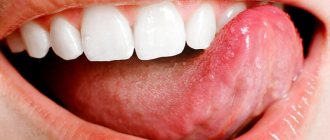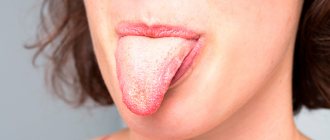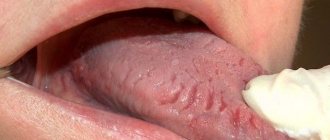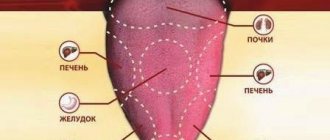The tongue is not just an organ of the digestive system, but also a specific indicator that unmistakably tells a person how the body is feeling at the moment, whether it needs special protection or not.
Often it is the language that attracts attention and makes you think about whether it’s time to see a doctor, despite the fact that your general condition and well-being in general do not cause concern.
It is by the condition of the tongue that many diseases are determined; even at a doctor’s appointment, examination of the tongue acts as one of the stages of diagnosis.
Anatomy and functions
The human tongue by its nature is a muscular organ that does not have bones. On top it is covered with a mucous membrane. Tasks and functions it performs:
- participates in the functioning of the speech apparatus;
- determines the taste of the food a person eats;
- is part of the digestive system - it performs primary processing of food, mixes it and forms a food bolus, which pushes further into the esophagus.
The structure of the language is simple but interesting. This organ is divided into two parts - the back - the root and the front - the body. The upper surface is also called the back and has a velvety structure.
The tongue is covered with papillae, which are divided into 4 groups responsible for recognizing tastes. That is why, with a burn or other injuries to the tongue, a person temporarily loses the ability to perceive one or more tastes.
What does a healthy tongue look like?
A healthy tongue without any pathologies should be pink and have a fold that runs along its entire surface. Also, the tongue in its normal state is soft to the touch and does not cause discomfort if it is moved while talking or eating. Taste buds are usually clearly distinguishable and pronounced.
A small amount of white coating is normal for a healthy tongue. Its quantity may vary depending on the season. Also, the presence of a thin whitish coating indicates a minor pathology that develops slowly and has a local location.
Plaque can lead to the appearance of:
- caries;
- gingivitis;
- gum pathologies;
- candidiasis.
Problems with the gastrointestinal tract, food allergies and lack of vitamins are the root cause of the formation of yellow or white plaque. Plaque thickening may indicate diseases, including chronic ones, requiring immediate consultation with a specialist.
Observation
After treatment, you need to undergo regular examinations, their frequency depends on how many years have passed since entering remission.
- In the 1st year - every 1-3 months.
- In the 2nd year - every 2-6 months.
- In 3-5 years - every 4-8 months.
- In the 6th year and thereafter – annually.
The following manipulations and examinations are carried out as control tests:
- medical instrumental examination of the oral cavity, peripheral lymph nodes;
- examination by a dentist if radiation therapy was performed in the oral cavity;
- endoscopic examination of the pharynx and oral cavity;
- for patients who have previously smoked - MRI (CT) of the soft tissues of the neck with contrast, CT of the chest and abdominal cavity with contrast. If necessary, PET with glucose, osteoscintigraphy.
All the colors of the rainbow in your mouth
Everyone knows that by the color of the tongue one can easily determine that something is wrong with the body, since some diseases are “reflected” on it by the characteristic color of the plaque. The most common of them:
- measles or flu, high fever - burgundy coating;
- lack of nutrition, anemia, heart failure - pale tongue;
- diseases of the blood or respiratory tract - purple plaque;
- problems with the gastrointestinal tract, smoking, jaundice - yellow or gray plaque;
- diseases of the liver, spleen, dysentery, abscesses, advanced viral diseases - black plaque;
- kidney disease - blue plaque;
- blood circulation disorders, heavy metal poisoning, scurvy - blue plaque;
- dehydration, fungal infection - white tongue;
- diseases of the oral cavity - dark brown plaque.
That is why it is important to pay attention to details, as they can tell more about health than the person himself.
Diagnostic Tool
The language, whose structure is complex, is an indicator of the state of the body. The following diseases are suggested by their appearance:
- yellow plaque indicates gastrointestinal diseases;
- trembling of the tip is a sign of neuroses, diseases of the nervous system;
- cracks are a symptom of digestive pathologies;
- deepening of the furrow is a symptom of a back problem;
- metabolic disorders - dry mucosa;
- light ulcers occur with gastritis, accompanied by high acidity;
- a bright, shiny surface is a sign of high temperature, infection;
- white plaque signals candidiasis and stomatitis.
A healthy back is smooth, velvety, pale pink in color. It does not leave the teeth, is moist, and has an even, straight central groove. Plaque appears due to anaerobic bacteria accumulating on the mucous membrane. An effective remedy is daily brushing with a toothbrush.
Sources:
- Kurepina M.M., Ozhigova A.P., Nikitina A.A. Human anatomy. Moscow, 2010.
- Fed.kovich N. Anatomy and physiology of man. Tutorial. Rostov-on-Don, 2003.
Plaque formation
The presence of a coating on the tongue of an unhealthy color indicates that changes are occurring in some specific organ or even group; there is a problem that requires attention and medical intervention. In order to understand exactly what is happening, you need to know the specific location of the plaque.
Most often, the color of the tongue and plaque differs, which makes it possible to determine the approximate system of organs in need of treatment.
The thickness of the plaque shows the severity of the problem - the thicker it is, the faster changes occur that are harmful to human health.
If the white coating forms in a thick layer, the gastrointestinal tract suffers, and the likelihood of constipation increases. If it is located in a thin layer on the tip of the tongue, the main problem is gastritis. At the same time, a thick layer on the tip of the tongue indicates complications with gastritis or that the disease has become chronic.
If plaque is located at the root of the tongue, then this is the first sign of inflammatory processes in the intestines. If the plaque is gray in color and concentrated at the root of the tongue, then one can judge about chronic diseases of the intestines and stomach, such as high acidity.
Plaque can also be yellow or black - this is a reason to think about the health of internal organs, including:
- spleen;
- gallbladder;
- liver.
A sign of serious pathology is a long period of persistence of plaque on the tongue. If the plaque lasts only a few hours or a day, then in this case it is necessary to take into account the fact that there is an imbalance in the microbial balance in the oral cavity.
Most likely, the cause is gastrointestinal problems, so consultation with a specialist in this field is necessary to prevent the situation from worsening.
It is important to remember that a white coating on the tongue may also indicate respiratory diseases, such as pneumonia.
This disease can be identified by the gradual darkening of plaque and its location along the edges of the tongue and on its front part. If darkening does not occur, then with a similar placement of plaque, we can talk about pneumonia.
The work of taste buds
The organ responsible for the perception of taste is the receptors. They are located on the sides of the taste buds. Thus , in smaller numbers they can be presented in the form of mushroom-shaped nipples. And on the sides, like leafy nipples. If you count, our tongue has more than nine thousand taste buds.
It is worth noting that small parts of taste buds, when they come into contact with food, transmit impulses to the nerves. Later they enter the brain . An interesting fact is that taste buds subsequently receive and transmit information. That is, it can transmit information to the brain about the state of food and its taste. Thus, a person has a complete picture of what he tastes. It is worth noting that women and children have impressions several times brighter than men.
It is worth remembering that he can recognize four basic tastes : sweet, salty, bitter and sour. Scientists also add alkaline, bitter and sour receptors to this category. Thus, some scientists may add some other tastes to this classification that have not been proven. If we talk about the taste of a particular product, it is worth understanding that all this is the result of the enormous work of the receptors.
Several years ago, scientists believed that each part of it reads a certain taste. Thus, taste buds are distributed on the tongue. For example, its end perceives only sweet taste. While its edges are responsible for the sour taste . Each type of taste bud can be distributed over the entire surface of the tongue. Each part of this organ can perceive any taste. Some of its regions can distinguish greater or lesser intensity of taste perception.
Formation of cracks
The tongue does not always have a perfectly flat surface. You can often see cracks on it. If there are many of them, then such a language is called “geographical”; it may indicate that problems with the gastrointestinal tract have become chronic, as well as that mental disorders are possible.
In addition, many cracks in the tongue indicate:
- disturbances in the functioning of parts of the brain;
- presence of an allergic reaction;
- somatic disorders in the body.
Also, if there are cracks in the tongue, you should consult a doctor, as pathology of the hypoglossal nerve is likely.
It can be recognized if, along with cracks, there is a deviation of the tongue to the side. Based on the location of the cracks, the side on which the organs are under stress or where there is a disease is diagnosed.
For example, if they are located exactly in the middle of the tongue, then there is a high probability of problems with the spine. A curved crack located at the root of the tongue indicates problems in the lumbar region, at the tip of the tongue, or in the cervical region.
Causes, risk factors
Possible causes of tongue cancer look like this:
- The influence of carcinogens in tobacco and other smoking mixtures.
- Constant exposure to alcohol on the tongue. Interesting fact: recent studies show that alcohol can enhance the effects of carcinogens found in tobacco.
- Contact with harmful substances: salts of heavy metals, asbestos, petroleum products - for example, when working in hazardous industries.
- Regular mechanical injuries to the tongue - biting, exposure to dentures, rubbing the tongue with a splintered tooth or poorly chosen filling, etc.
- The effect on the body of HPV - specifically strains that have a high oncogenic risk. People with HIV and other viruses are also at risk.
- Precancerous conditions of the tongue, which can later develop into cancer. These are chronic ulcers, papillomas, lichen planus, Bowen's disease, etc.
Obviously, not all reasons can cause tongue cancer (and not always) - we are only talking about a significant increase in risks.
Ulcers and wounds on the tongue
Ulcers on the surface of the tongue are not uncommon and can occur for a variety of reasons:
- tongue injury;
- burn;
- dental problems in the oral cavity;
- Crohn's disease and other gastrointestinal problems.
Usually the ulcers are small in size, but present in large numbers, so they cause a lot of inconvenience and discomfort to a person. It is impossible to ignore wounds and ulcers on the tongue, especially if they arise without a reason.
One of the types of disease in which the body gives such a symptom is syphilis, therefore, treatment should be immediate and professional. However, in the case of this disease, the ulcer will be present on the tongue in the singular.
Its surface is bright red, shiny and hard. In addition, it is completely painless. The formation of warts at the root of the tongue or on its sides is a sign of HIV, and flat ulcers on the tip of the tongue, the sides or along the midline indicate the onset of tuberculosis.
Methods of treating the disease
Treatments for this type of cancer include surgery, radiation therapy, and chemotherapy. Let's consider these methods separately.
Surgery
The main method of treatment is resection (removal) of the tumor. The principle of the surgical technique is to remove a malignant tumor from the patient. Surgery is always performed, except in cases where the tumor is inoperable.
Operation options:
- Gentle resection, in which the tongue or most of it is preserved.
- Radical removal (the operation is called glossectomy, this is the total removal of the tongue).
- Together with glossectomy or after it, reconstruction of the tongue is often performed - one-stage plastic surgery with a skin flap. This intervention allows you to preserve the functions of the removed organ.
Radiation therapy
Radiation is designed to destroy cancer cells or slow their growth. For small tumors this is the main treatment method. Radiation can also be given before surgery (to reduce the tumor) and after it (to avoid relapse). In later stages, the technique is used as palliative therapy, that is, it alleviates symptoms.
Chemotherapy
This is a systemic therapy that aims to destroy malignant cells throughout the body. Chemotherapy is given before surgery (to shrink the tumor) or after it (to avoid relapse).











